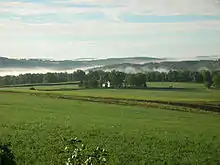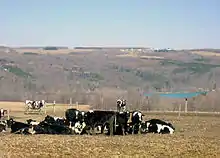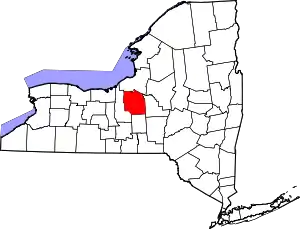Skaneateles (town), New York
Skaneateles (/ˌskæniˈætləs/ SKAN-ee-AT-ləs, locally /ˌskɪn-/ SKIN-)[4] is a town in Onondaga County, New York, United States. The population was 7,209 at the 2010 census.[2] The name is from the Iroquois term for the adjacent Skaneateles Lake, which means "long lake." The town is on the western border of the county and includes a village, also named Skaneateles. Both town and village are southwest of Syracuse.
Skaneateles | |
|---|---|
 A home on the west shore of Skaneateles Lake | |
| Nickname(s): Skantown
Skan | |
_highlighted.svg.png.webp) Location in Onondaga County and the state of New York. | |
| Coordinates: 42°56′28.79″N 76°25′25.19″W | |
| Country | United States |
| State | New York |
| County | Onondaga |
| Government | |
| • Type | Town Council |
| • Town Supervisor | Janet Aaron (R) |
| • Town Council | Members
|
| Area | |
| • Total | 48.83 sq mi (126.46 km2) |
| • Land | 42.61 sq mi (110.35 km2) |
| • Water | 6.22 sq mi (16.11 km2) |
| Population | |
| • Total | 7,209 |
| • Estimate (2016)[3] | 7,254 |
| • Density | 170.26/sq mi (65.74/km2) |
| Time zone | UTC-5 (Eastern (EST)) |
| • Summer (DST) | UTC-4 (EDT) |
| Area code(s) | 315 Exchanges: 291,685,707 |
| FIPS code | 36-067-67521 |
| Website | townofskaneateles |
History
The area was part of the former Central New York Military Tract. The town of Skaneateles was formed in 1830 from the town of Marcellus. Early turnpikes facilitated development. The town was noted for participation in reform movements before the Civil War.
The Skaneateles Community in 1843 acquired and successfully operated a large farm and developed small industries. It ultimately failed because of internal difficulties, as well as external concern about its unorthodox social practices. Locally it was sometimes called "No God," because of the atheistic views of members. The Skaneateles Community published a newspaper, the "Comunitist" [sic] between 1844 and 1846, when the community dissolved. Buildings are extant, known as "Community Place," now serving as a bed-and-breakfast.
Some Skaneateles men volunteered for the ill-fated Upper Canada Rebellion (1837) to liberate Canada and were imprisoned by the British in Australia. Quaker congregations were involved in abolition activity. Underground Railroad sites have been documented in Skaneateles. Although the larger city of Syracuse nearby was known nationally as a center of abolition and Underground Railroad activity, Skaneateles was said (by Beauchamp, an early historian) to have "eclipsed Syracuse as an anti-slavery town."
On July 4, 1876, resident John Dodgson Barrow delivered centennial address in Skaneateles recounting the history of the village up to that time.[5] In 1891, he had it printed in Syracuse as a 20-page book.[6]
The Brook Farm, Community Place, and Kelsey-Davey Farm are listed on the National Register of Historic Places.[7]
Geography
According to the United States Census Bureau, the town has a total area of 48.8 square miles (126.3 km2), of which, 42.7 square miles (110.5 km2) of it (87.49%) is land and 6.1 square miles (15.8 km2) of it (12.51%) is water.
Demographics
| Historical population | |||
|---|---|---|---|
| Census | Pop. | %± | |
| 1830 | 3,812 | — | |
| 1840 | 3,981 | 4.4% | |
| 1850 | 4,081 | 2.5% | |
| 1860 | 4,335 | 6.2% | |
| 1870 | 4,524 | 4.4% | |
| 1880 | 4,866 | 7.6% | |
| 1890 | 4,662 | −4.2% | |
| 1900 | 4,205 | −9.8% | |
| 1910 | 4,274 | 1.6% | |
| 1920 | 4,247 | −0.6% | |
| 1930 | 4,795 | 12.9% | |
| 1940 | 4,639 | −3.3% | |
| 1950 | 5,193 | 11.9% | |
| 1960 | 6,603 | 27.2% | |
| 1970 | 7,825 | 18.5% | |
| 1980 | 7,795 | −0.4% | |
| 1990 | 7,526 | −3.5% | |
| 2000 | 7,323 | −2.7% | |
| 2010 | 7,209 | −1.6% | |
| 2016 (est.) | 7,254 | [3] | 0.6% |
| U.S. Decennial Census[8] | |||

As of the census[9] of 2000, there were 7,323 people, 2,881 households, and 2,082 families residing in the town. The population density was 171.7 people per square mile (66.3/km2). There were 3,233 housing units at an average density of 75.8 per square mile (29.3/km2). The racial makeup of the town was 98.99% White, 0.10% Black or African-American, 0.10% Native American, 0.36% Asian, 0.04% from other races, and 0.42% from two or more races. Hispanic or Latino of any race were 0.42% of the population.
There were 2,881 households, out of which 33.6% had children under the age of 18 living with them, 62.2% were married couples living together, 7.6% had a female householder with no husband present, and 27.7% were non-families. 24.3% of all households were made up of individuals, and 13.0% had someone living alone who was 65 years of age or older. The average household size was 2.54 and the average family size was 3.03.
In the town, the population was spread out, with 26.5% under the age of 18, 4.4% from 18 to 24, 24.5% from 25 to 44, 28.3% from 45 to 64, and 16.3% who were 65 years of age or older. The median age was 42 years. For every 100 females, there were 95.3 males. For every 100 females age 18 and over, there were 89.8 males.
The median income for a household in the town was $57,550, and the median income for a family was $69,023. Males had a median income of $51,621 versus $31,250 for females. The per capita income for the town was $28,624. About 1.8% of families and 3.2% of the population were below the poverty line, including 1.1% of those under age 18 and 3.7% of those age 65 or over.

.jpg.webp)
Communities and locations in the Town of Skaneateles
- Highland Way – A neighborhood just east of Skaneateles village on Onondaga Rd.
- Jones Beach – A hamlet on the east shore of Skaneateles Lake on NY-41.
- Long Bridge – A hamlet at the north town line, north of Mottville.
- Mandana – A hamlet down the west side of the lake.
- Mottville – A hamlet two miles north of Skaneateles village on Jordan Street and north of Willow Glen.
- Shepard Settlement – A farming hamlet.
- Skaneateles – A village at the north end of Skaneateles Lake.
- Skaneateles Falls – A hamlet northwest of Skaneateles village on Skaneateles Creek.
- Thornton Grove – A lakeshore neighborhood on the west shore of the lake south of Winding Way.
- Thornton Heights – A lakeshore neighborhood on the west shore of the lake home of the Veggie Stand.
- Wicks Corners – A neighborhood on the west town line, northwest of Skaneateles village.
- Willow Glen – A neighborhood on Old Seneca Turnpike, north of Skaneateles village.
- Winding Way – A neighborhood on the west shore of Skaneateles Lake.
Notable people
- John Dodgson Barrow (1824-1906), Hudson River School artist[10]
- Mary Elizabeth Beauchamp (1825–1903), educator and author
- Neilia Hunter Biden (July 28, 1942 – December 18, 1972), first wife of Joe Biden, mother of Beau Biden and Hunter Biden
- Barry Crimmins (1953-2018), comedian, activist
- Clara Cannucciari (1915-2013), web vlogger, author
- Sheldon Dibble (1809-1845), missionary
- Searles G. Shultz, (April 29, 1897 – January 23, 1976) American Lawyer and Politician
- Marshall I. Ludington, (July 4, 1839 - July 26, 1919) Quartermaster General of the United States Army[11]
References
- "2016 U.S. Gazetteer Files". United States Census Bureau. Retrieved Jul 5, 2017.
- "U.S. Census website". United States Census Bureau. Retrieved 2011-05-14.
- "Population and Housing Unit Estimates". Retrieved June 9, 2017.
- Kenyon, John S.; Knott, Thomas A. (1953). A Pronouncing Dictionary of American English. Springfield, Mass.: Merriam-Webster. p. 393. ISBN 0-87779-047-7.
- Beauchamp, William Martin (1908). Past and Present of Syracuse and Onondaga County, New York: From Prehistoric Times to the Beginning of 1908. Onondaga County (N.Y.): S.J. Clarke Publishing Company. p. 288. Retrieved 25 November 2020.
- Barrow, John D. (July 4, 1876). "Centennial Address by John D. Barrow". Skaneateles, New York: Masters & Stone Printers. Retrieved 25 November 2020.
- "National Register Information System". National Register of Historic Places. National Park Service. March 13, 2009.
- "Census of Population and Housing". Census.gov. Retrieved June 4, 2015.
- "U.S. Census website". United States Census Bureau. Retrieved 2008-01-31.
- Blakney, Susan S. (September 1988). "A Conservation Strategy For a Static Non-funded Collection: The John D. Barrow Art Gallery" (PDF). The Abbey Newsletter. 12 (6). Retrieved 25 November 2020.
- The National Cyclopaedia of American Biography. XVIII. New York, NY: James T. White & Company. 1922. p. 284 – via Google Books.
Bibliography
- Beauchamp, William. "Notes of other days in Skaneateles", Skaneateles Democrat, 1876. Cornell Library New York State Literature
- Hamm, Thomas D., God's Government Begun: The Society of Universal Inquiry and Reform, 1842-1846. Indian University Press, 1995.
- Hamm, Thomas D. "Skaneateles Community." Encyclopedia of New York State, Syracuse University Press, 2005.
- Fogarty, Robert. "Utopian and Intentional Communities," The Encyclopedia of New York State. Syracuse University Press, 2005.
- Jay, Gregory S., "America the scrivener: Deconstruction and the subject of literary history." Cornell University Press, 1990.
- Smithana, Don. "America—Land of the Rising Sun, 1989 Tokuma Shoten, Tokyo
